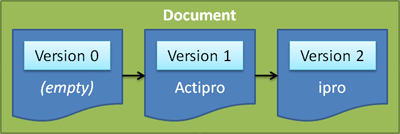Documents, Snapshots, and Versions
Documents, snapshots, and versions are used to store text data. Documents allow for text updates, while a snapshot provides an immutable view of text within a document for a certain version that can be read.
Looking at a Document's Current Text Data
The ITextDocument interface has a CurrentSnapshot property that returns the "current" ITextSnapshot for the document.
Think of ITextSnapshot objects like .NET strings. They are immutable, meaning their contents cannot be changed, and they can be used across threads. Therefore, you are able to examine and parse a snapshot without fear of its contents changing from some other operations in a separate thread.
There are multiple ways to examine text in a snapshot, some of the most common are described below.
Object Relationships
ITextDocument objects only store a reference to the "current" ITextSnapshot, meaning the snapshot the specifies the text contents of the document at this point in time.
Each snapshot is related to a single version. Therefore, each ITextSnapshot has a Version property that returns a reference to its ITextVersion. The ITextVersion has a version number.

A sequence of text changes made, showing how new snapshots and versions are created
As changes are made to a document, new snapshots and related versions are created. For instance, a blank document would have a current snapshot with version 0. If the text "Actipro" was appended to the document, it would now have a current snapshot with version 1. If the first three characters were removed, the document would now have a current snapshot with version 2. And so on.
Essentially, the version increments with any change and provides the data needed for snapshot translation. Each snapshot references a single version, and the snapshot contains a complete immutable copy of the text that is related to the version.
Memory Usage and Performance
After reading above that every change creates a completely new immutable copy of the document text in a snapshot, it would be conceivable to think that memory usage would be enormous and performance would suffer, especially for large documents.
Actually, this is not the case at all. Snapshots are designed to share data as much as possible that is not different between consecutive snapshots. Besides that, once a snapshot is no longer referenced by your code, it and its contents drop out of memory. Therefore, there really isn't much of a memory impact by adding the great features provided by snapshots.
It's also important to mention that snapshots and their creation are designed to be very fast. There is no performance decrease by using them.
Reading Text, Use Snapshots
Whenever you need to read or examine the contents of a document, get the ITextDocument.CurrentSnapshot and use the snapshot's various properties and methods.
These members on ITextSnapshot are related to reading text:
| Member | Description |
|---|---|
| GetReader Method | Returns an ITextSnapshotReader that can be used to navigate through the text and token contents of the snapshot. |
| GetSubstring Method | Returns a substring from the snapshot text using the specified LineTerminator for line ends. |
| GetText Method | Returns the entire text of the snapshot using the specified LineTerminator for line ends. |
| GetWordText Method | Gets the text of the word at the specified offset. |
| Length Property | Gets the number of characters in the snapshot, excluding any carriage-returns but including newlines. |
| Lines Property | Gets the collection of ITextSnapshotLine objects, each of which represents a line in the snapshot. |
| Text Property | Gets the entire text of the snapshot using LineTerminator.CarriageReturnNewline for line ends, which is not intended to be used for parsing for classification reasons. |
Writing Text, Use Document
Whenever making text changes to a document, thereby creating a new snapshot, use methods on the ITextDocument interface.
The Text Changes and Operations topic talks about making text changes in details. See that topic for information on modifying a document.
Multiple Snapshots and Snapshot Translation
As displayed by the diagram above, multiple snapshots can be active for a document at any given time. Sometimes it's useful to store an offset range of text that was parsed from a particular snapshot and at some later arbitrary time, see where the same range is in the "current" snapshot for a document.
This can easily be done and is really a neat feature provided by the snapshot/version design.
See the Snapshot Translation topic for more information on doing this.